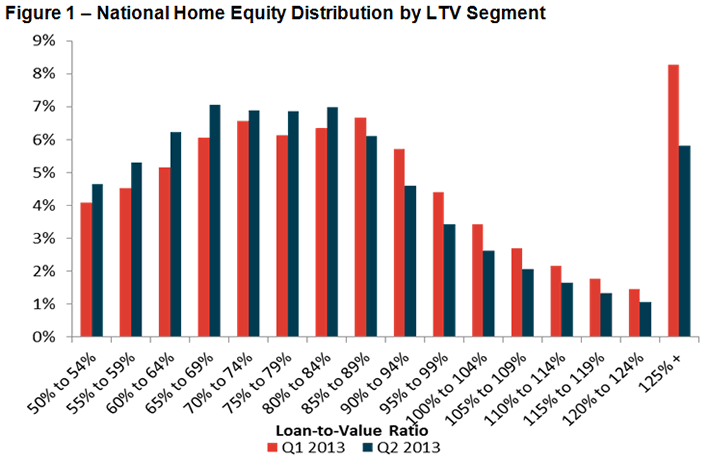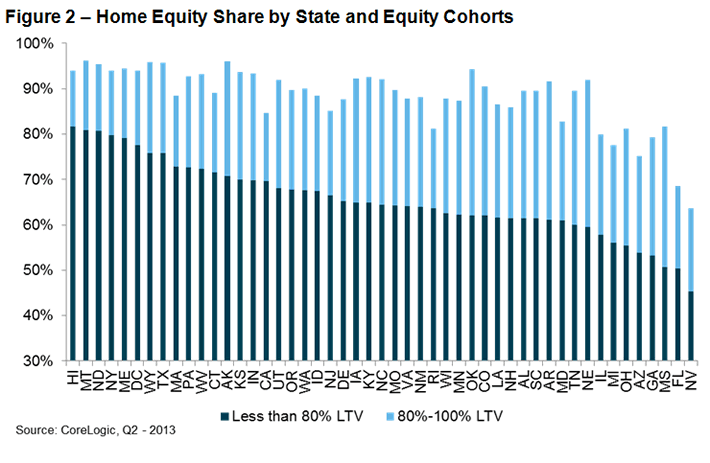Blog

CoreLogic Confirms Improving Equity Picture, but Pace may Change
While they don’t agree on the numbers or use the same timeframes, therntwo reports on underwater mortgages released in the last week do conclude thatrnhomeowners are rapidly recapturing the equity they lost so suddenly late in thernlast decade. Last week RealtyTracrnannounced its findings that some 600,000 homeowners had emerged from being “deeplyrnunderwater” (that is with loan-to-value ratios in excess of 125 percent) justrnsince May. Today CoreLogic said thatrnmore than 2.5 million more residential properties became equity-positive duringrnthe second quarter.</p
The CoreLogic report put the number of mortgaged residential propertiesrnwith equity at 41.5 million and the number still underwater at 7.1 million orrn14.5 percent of all homes with a mortgage. At the end of the previous quarterrnthere were 9.6 million homes or 19.7 percent that were underwater.</p
Of those properties with positive equity CoreLogic says 10.3 million orrn21.1 percent have less than 20 percent equity which means their owners may haverndifficulty refinancing or selling their homes due to underwritingrnconstraints. Of these 1.7 millionrnproperties had less than 5 percent equity and are at risk of being in negative territoryrnagain with even a slight decline in home prices. </p
 </p
</p
The national aggregate value of negative equity was $428 billion at thernend of the second quarter compared to $576 billion at the end of the firstrnquarter of 2013, a decrease of more than $148 billion, driven in large part,rnaccording to CoreLogic by an improvement in home prices.</p
Of the total negative equity $217 billion or about half belonged tornsome 4.3 million borrowers with only one mortgage on their property. These borrowers were underwater an average ofrn$51,000. Some 2.8 million homeowners hadrnhome equity loans in addition to first mortgages and accounted for thernremaining $211 billion in aggregate negative equity. Their average underwater amount was $75,000</p
“Equity rebuilding continued in the second quarter of this year as thernshare of underwater mortgaged homes fell to 14.5 percent,” said Dr. MarkrnFleming, chief economist for CoreLogic. “In just the first half of 2013 almostrnthree and a half million homeowners have returned to positive equity, but thernpace of improvement will likely slow as price appreciation moderates in thernsecond half.”</p
“Pricernappreciation obviously had a positive impact on home equity over the first halfrnof 2013, especially the second quarter,” said Anand Nallathambi, president andrnCEO of CoreLogic. “Despite the substantial decrease in negative equity, there’srnmore ground left to gain with the 7.1 million U.S. residences that remainrnunderwater.”</p
The bulk of home equity for mortgaged properties isrnconcentrated at the high end of the housing market. For example, 91 percent of homesrnvalued at greater than $200,000 have equity compared with 80 percent of homesrnvalued at less than $200,000.</p
Negative equity was highest in Nevada (36.4 percent), Florida (31.5rnpercent), Arizona (24.7 percent), Michigan (22.5 percent), and Georgia (20.7 percent).rnThese top five states combined account for 34.9 percent of negative equity inrnthe U.S.</p

All Content Copyright © 2003 – 2009 Brown House Media, Inc. All Rights Reserved.nReproduction in any form without permission of MortgageNewsDaily.com is prohibited.
Latest Articles
By John Gittelsohn August 24, 2020, 4:00 AM PDT Some of the largest real estate investors are walking away from Read More...
Late-Stage Delinquencies are SurgingAug 21 2020, 11:59AM Like the report from Black Knight earlier today, the second quarter National Delinquency Survey from the Read More...
Published by the Federal Reserve Bank of San FranciscoIt was recently published by the Federal Reserve Bank of San Francisco, which is about as official as you can Read More...

Comments
Leave a Comment